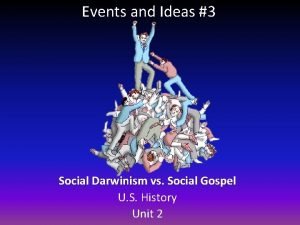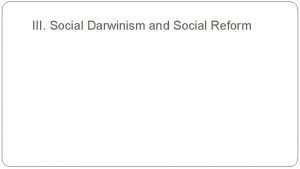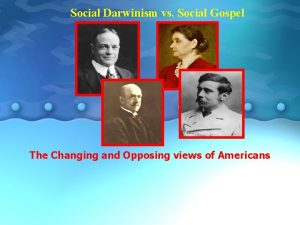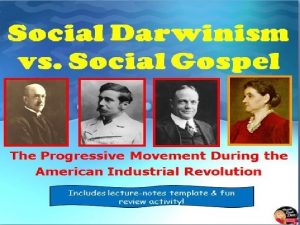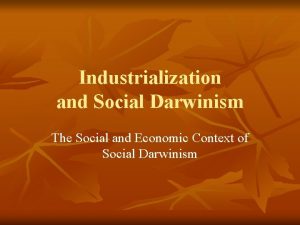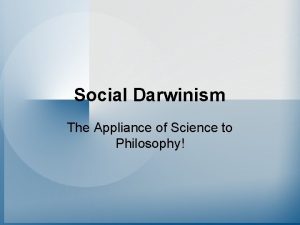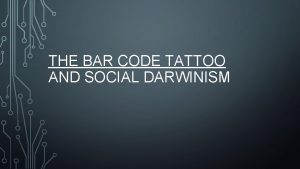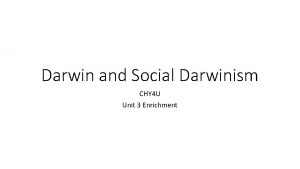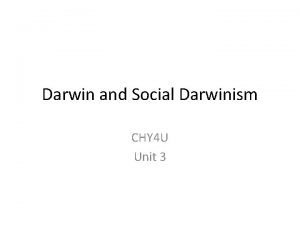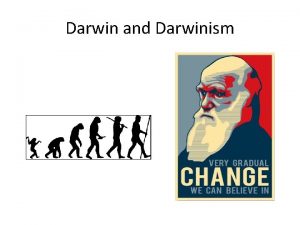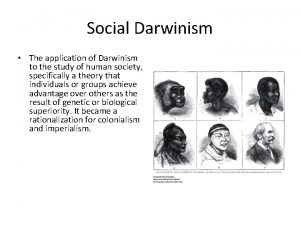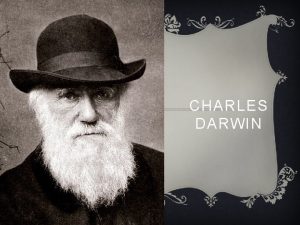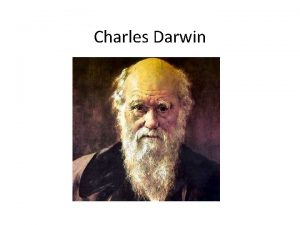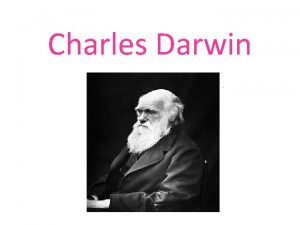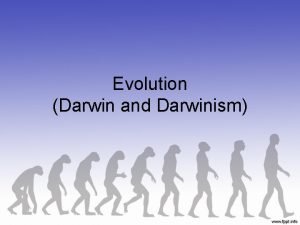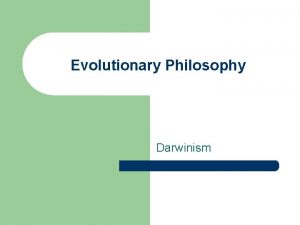Darwin and Social Darwinism CHY 4 U Unit













- Slides: 13

Darwin and Social Darwinism CHY 4 U Unit 3 Enrichment

How did natural selection shape views and perspectives of the 19 th century? Darwin Traditional Thinking Scientific thinking Religious dogma The environment is key Divine creation Change and progress are possible and common Change is not desirable – God created everything perfectly

How Darwin Began to Think About Nature and the Environment Differently A Voyage on the Beagle that lasted over five years, 1831 -1836.

In 1835 Darwin examined finches (birds) on Galapagos Islands… Although the islands were relatively close together, formed by the same rocks, with similar climates, at similar heights… the species of finches between the islands were different! Jonathan Clements, Darwin’s Notebook: The Life, Times, and Discoveries of Charles Robert Darwin (London: Quid Publishing, 2009), 50.

“The most curious fact is the perfect gradation in the size of the beaks in the different species of Geospiza*, from one as large as that of a hawfinch to that of a chaffinch… there are no less than six species with insensibly graduated beaks… Seeing this gradation and diversity of structure in one small, intimately related group of birds, one might really fancy that from an original paucity [scarcity] of birds in this archipelago, one species had been taken and modified [changed] for different ends. ” Paul’s Birding Diary, http: //paulsbirdingdiary. blogspot. ca/2013/03/hawfinch-and-othergarden-birds. html *A type of finch Jonathan Clements, Darwin’s Notebook: The Life, Times, and Discoveries of Charles Robert Darwin (London: Quid Publishing, 2009), 65.

It turned out that the finches Darwin saw in the Galapagos Islands were from different species who had each adapted to somewhat different environments. This got him thinking about change in nature. PBS. Evolution Library. Adaptive Radiation – Darwin’s Finches. 2001. http: //www. pbs. org/wgbh/evolution/library/01/6/image_pop/l_016_02. html (Nov. 10, 2011)

How did other scientific developments help Darwin shape views in 19 th century England?

Influence of Charles Lyell Pillars showing flood levels from the past. • In 1830, Lyell published Principles of Geology • The book argued that slow natural forces, not Biblical forces, affected the earth’s formation • In particular, the earth’s crust shifted. Darwin experienced an earthquake while in Chile and saw the ground rise by eight feet. PBS, Evolution, 2001 <http: //www. pbs. org/wgbh/evolution/library/02/4/image_pop/l_024_01. html> (April 28, 2008).

Influence of Thomas Malthus • In 1838, Malthus saw that the inequalities created by Britain’s industrialization were having an effect. • The owners become rich through the means of production, while the workers were exploited • Through urbanization, cities became more crowded and ordinary people struggled for their daily existence. • Population growth would lead to an inevitable shortfall of food (see graph). • Humans were in a ceaseless struggle for existence to survive famine, disease and war. • This got Darwin thinking about struggle.

• “These ideas galvanized Darwin’s thinking about the struggles for survival in the wild, where restraint is unknown. Before reading Malthus, Darwin had thought that living things reproduced just enough individuals to keep population stable. But now he came to realize that, as in human society, populations bred beyond their means, leaving survivors and losers in the effort to exist. ” PBS, Evolution – Darwin and Malthus, 2001 , http: //www. pbs. org/wgbh/evolution/library/02/5/1_25_01. html (April 24, 2015).

Social Darwinism • How might Darwin’s theory of “the survival of the fittest” be misapplied to various human races?

• Social Darwinism: theory that persons, groups, and races are subject to the same laws of natural selection as Charles Darwin had perceived in plants and animals in nature. • Popular in the late 19 th and early 20 th century • The struggle for existence is present between humans in society • Survival of the fittest: The cultures of weaker groups would be limited by the power and cultural influence of stronger groups

• Darwinism in a social context: • sociocultural progress is the product of intergroup conflict and competition • the socially elite classes (as those possessing wealth and power) possess biological superiority in the struggle for existence See imperialism case studies.
 Social darwinism paralleled the economic doctrine of
Social darwinism paralleled the economic doctrine of Lesson 3 social darwinism and social reform
Lesson 3 social darwinism and social reform Social darwinism vs social gospel venn diagram
Social darwinism vs social gospel venn diagram Social darwinism vs social gospel
Social darwinism vs social gospel Social darwinism vs social gospel
Social darwinism vs social gospel Hy chy ky ry dy ty ny básnička
Hy chy ky ry dy ty ny básnička Hy chy ky ry dy ty ny na zdi visí hodiny
Hy chy ky ry dy ty ny na zdi visí hodiny Chy china
Chy china Chy china
Chy china Dvouhlásky
Dvouhlásky Social darwinism and industrialization
Social darwinism and industrialization Herbert spencer social darwinism
Herbert spencer social darwinism Social darwinism definition
Social darwinism definition Darwinism
Darwinism
